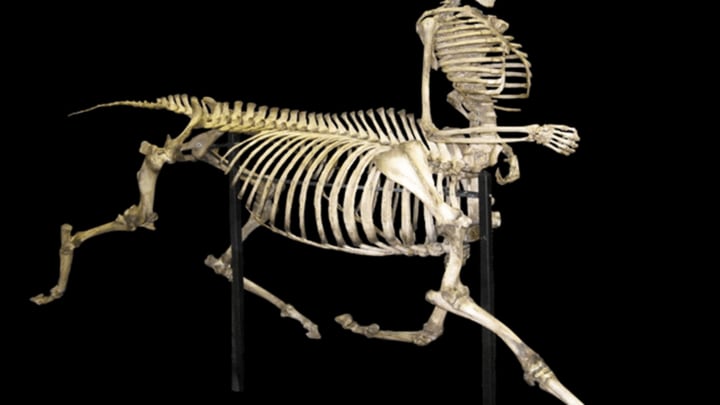The anatomy of a centaur (half man, half horse) raises a lot of questions. For instance, which organs go where? And what’s the purpose of having two torsos? If scientists could only get their hands on some ancient centaur remains, maybe it would clear things up. Sadly, the centaur skeleton currently on display at the John C.Hodges Library at the University of Tennessee, Knoxville is a piece of art, not science.
The remains of the “Centaur of Volos” were fabricated in 1980 by artist and biology professor Bill Willers when he felt inspired to combine the bones of a human specimen from his university's biology department with those of a Shetland pony. After tea-staining them both for an authentic, consistent look, the first-ever centaur skeleton was born.
The bone sculpture was first displayed at the Madison Art Center before touring other colleges in the mid-1980s. By the '90s, it had ended up in storage, much to the dismay of two professors at the University of Tennessee, Knoxville. Beauvais Lyons (currently Ellen McClung Berry Professor of Art) and Neil Greenberg (Emeritus Professor of Ecology and Evolutionary Biology) campaigned to raise money to purchase the fictitious artifact and were ultimately successful.
Since 1994, the piece has been on display at the university’s John C. Hodges Library as part of an exhibit called The Centaur Excavations of Volos. Instead of standing on four legs, the skeleton is half-buried in an artificial dig site surrounded by ceramic artifacts. The exhibit also includes an anatomically-correct centaur illustration and a plaque that reads, "one of three centaur burials discovered in 1980 by the Archaeological Society of Argos Orestiko eight kilometers northeast of Volos, Greece.”
Even after three decades, Bill Willers’s centaur fixation is still going strong. In 2008, he commissioned a standing centaur made from a human skeleton and that of a zebra that he called the Centaur of Tymfi. We’re not entirely sure if a half-man, half-zebra constitutes a centaur, but we’ll let this one slide.
[h/t: Strange Remains]
